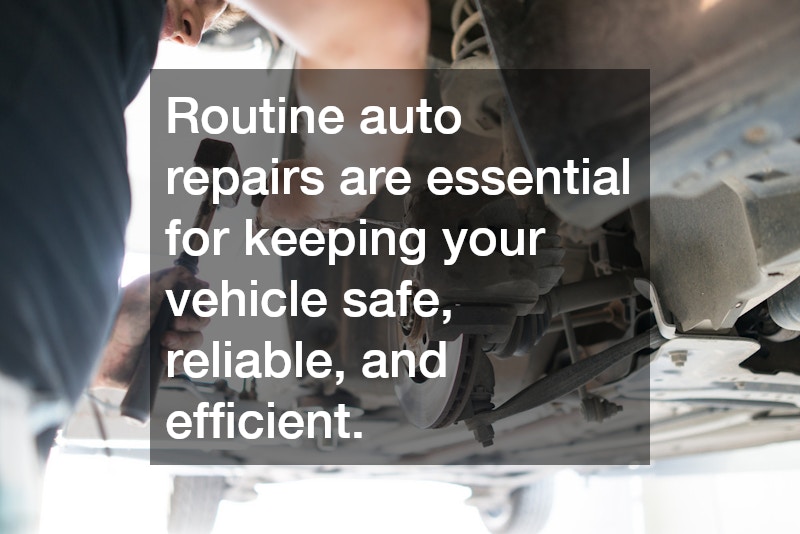Keeping your vehicle in good condition is essential for safety, performance, and longevity. Routine auto repairs play a vital role in maintaining your car’s health by addressing minor issues before they become major problems. For many car owners, the idea of taking a vehicle in for repairs can be stressful or confusing, especially if they don’t know what to expect during the process.
This blog will guide you through what typically happens during routine auto repairs, helping you feel more confident and informed when your vehicle needs service.
Understanding Routine Auto Repairs
Routine auto repairs generally refer to regular maintenance tasks and minor fixes that keep your vehicle running smoothly. These can include oil changes, brake inspections, tire rotations, fluid top-ups, and filter replacements.
While these services may seem simple, they are crucial for preventing breakdowns and expensive repairs down the line.
Many vehicle manufacturers recommend a schedule for routine maintenance based on mileage or time intervals. Following these recommendations ensures that your car operates efficiently and safely. When you bring your vehicle in for routine repairs, the technicians will perform a series of checks and replacements as needed.
The Initial Vehicle Inspection
When you arrive at the repair shop, the first step is usually a thorough inspection of your vehicle. This initial assessment helps the technicians identify any issues that need attention beyond the standard maintenance tasks. They may check fluid levels, look for leaks, assess tire tread and pressure, inspect brake pads and rotors, and evaluate the condition of belts and hoses.
This inspection can uncover potential problems before they lead to breakdowns, allowing you to address them proactively. The technician will typically provide you with a detailed report of what they found, along with recommendations for any necessary repairs or replacements.
Communication and Estimates
Clear communication between you and the repair shop is essential. After the inspection, the technician should explain what needs to be done in understandable terms, outlining the parts and labor involved. They will usually provide an estimate of the total cost and the expected time frame for completing the repairs.
Don’t hesitate to ask questions if anything is unclear or if you want to know why a particular repair is necessary. A trustworthy auto repair shop values transparency and will ensure you understand the work being performed.
Performing the Repairs
Once you approve the estimate, the technicians will begin the repair work. For routine maintenance, this often includes tasks like changing the engine oil and oil filter, replacing air filters, topping off or flushing fluids (such as coolant, brake fluid, and transmission fluid), rotating tires, and inspecting or replacing brake components.
Technicians use specialized tools and equipment to perform these repairs efficiently and correctly. For example, oil changes involve draining the old oil, replacing the filter, and adding fresh oil to the engine. Tire rotations require moving tires from one position to another to ensure even wear and extend tire life.
During this process, the technicians will also check for any signs of wear or damage that might not have been obvious during the initial inspection. If they discover additional issues, they will contact you before proceeding with further repairs.
Quality Checks and Final Inspection
After completing the repairs, the technicians conduct quality checks to ensure everything is functioning properly. This may involve testing the vehicle’s systems, such as brakes and fluid levels, and sometimes taking the car for a short test drive.
The goal is to confirm that the repairs have resolved the issues and that your vehicle is safe to drive. The final inspection helps catch any oversights and guarantees that you receive a reliable and thorough service.
Receiving Your Vehicle and Documentation
When your vehicle is ready, the repair shop will notify you for pickup. Along with your keys, you should receive documentation detailing the services performed, parts replaced, and any recommendations for future maintenance.
Keep these records, as they are important for tracking your vehicle’s maintenance history and can be helpful when selling your car or addressing warranty claims.
How to Prepare for Routine Auto Repairs
Preparing for routine repairs can make the process smoother and less stressful. Schedule appointments in advance, especially during busy seasons, to ensure timely service. Bring any warranty information, service records, or manuals related to your vehicle.
If you have concerns or specific symptoms you’ve noticed while driving, write them down to discuss with the technician. Providing detailed information can help diagnose issues more accurately.
Knowing When to Seek Routine Auto Repairs
Regularly scheduled maintenance is crucial, but you should also seek routine auto repairs if you notice warning signs like unusual noises, vibrations, dashboard warning lights, or changes in handling. Addressing these early can prevent more extensive damage.
If you are unsure about the appropriate maintenance schedule, consult your vehicle’s owner’s manual or speak with a trusted mechanic.
Routine auto repairs are essential for keeping your vehicle safe, reliable, and efficient. Understanding what to expect during these services—from initial inspection to final quality checks—helps you feel confident and informed when bringing your car in for maintenance.
By choosing a reputable repair shop and communicating openly with technicians, you ensure your vehicle receives the care it needs. Regular attention to your car through timely auto repairs not only extends its lifespan but also saves you money by preventing costly breakdowns. Taking these steps supports safer driving and a smoother ride for years to come.

